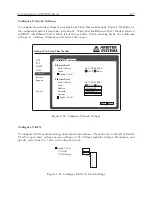
134
Options List
C.14.3
Firmware Configuration.
Setup for Option 32/33 operation is in two parts: (1) setting the correct option number (i.e. 32 or
33) via the front panel, or through the RS-232 port (1093A); (2) configuring the NTP server(s) via
the the individual Ethernet port, or option RS-232 port.
Front Panel (1093B/C)
1. Apply power and observe the front panel display; press the SETUP key when it displays
“CLOCK STATUS STARTUP”.
2. Navigate through the series of menu selections, using either the DOWN, UP or SETUP key,
until “SET OPTION CONTROL?” appears; press ENTER; the display should read “MAIN
BOARD OPTION”; press ENTER and it should read “AUX. BOARD OPTION”; press
ENTER.
3. Press the UP or DOWN key to select 32 or 33 and ENTER.
4. Press any of the upper row of keys to exit the configuration menu.
RS-232 Port (1093A)
To set up Option 32/33 in the 1093A, you will need to use a terminal program like HyperTerminal
or Tera Term Pro. For Option 32, type the following in the terminal window, “1,6,1093XI”; for
Option 33, type “1,7,1093XI”.
NTP Module
The NTP module can be configured over the appropriate Ethernet port or the option RS-232 port.
The Ethernet is the preferred port to configure, with no required jumper changes.
Ethernet
Initially, NTP servers are programmed with the IP address of 192.168.0.232. To configure the NTP
module over the network, establish a Telnet connection to port 9999. If the IP address of the NTP
Server (NTS) is unknown or undefined, the following sets a temporary IP address:
a)
Set a static ARP with the desired IP address using the hardware address of the NTS, which
is printed on the product label. Alternately, you can calculate the address from the serial number.
Below is the command example for WinXP, using the DOS prompt, when the hardware address of
the NTS is 00-20-4A-02-64-0B.
arp -s 192.168.0.232 00-20-4A-02-64-0B
NOTE:
In order for the ARP command to work in Windows, the ARP table on the PC must
have at least one IP address defined other than its own. Type “ARP A” at the DOS command
prompt to verify that there is at least one entry in the ARP table. If there is no other entry beside
the local machine, ping another IP machine on your network to build the ARP table. This has to
be a host other than the machine that you’re working on. Once there is at least one entry in the
ARP table, use the listed commands to ARP an IP address to the NTP Server.
The command example for most Unix systems is:
arp -s 192.168.0.232 00:20:4A:02:64:0B
b)
Open a telnet connection to port number 1. This connection will fail, but the NTS will
change its IP address to the desired one in that step, e.g.
Summary of Contents for 1092A
Page 4: ...iv ...
Page 18: ...xviii LIST OF TABLES ...
Page 129: ...C 10 Option 20A Four Fiber Optic Outputs 111 Figure C 7 Option 20A Jumper Locations ...
Page 131: ...C 11 Option 27 8 Channel High Drive 113 Figure C 8 Option 27 Jumper Locations ...
Page 148: ...130 Options List Figure C 10 Option 29 Connector Signal Locations ...






























